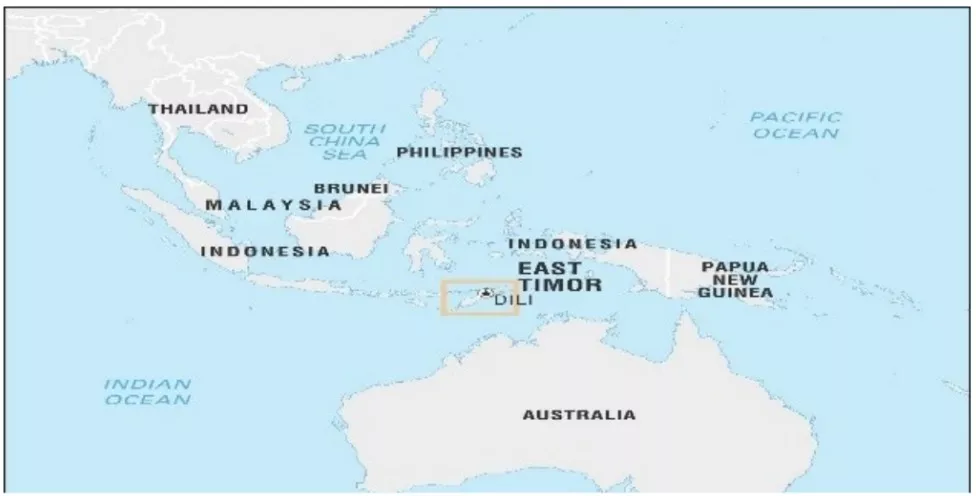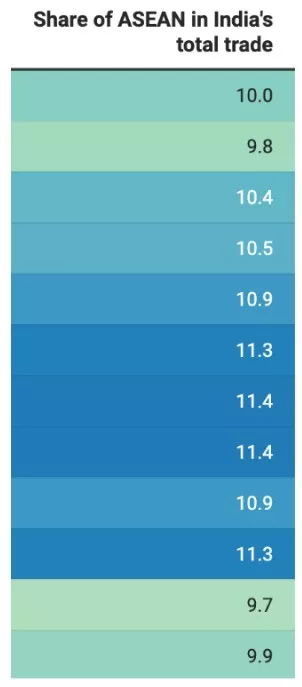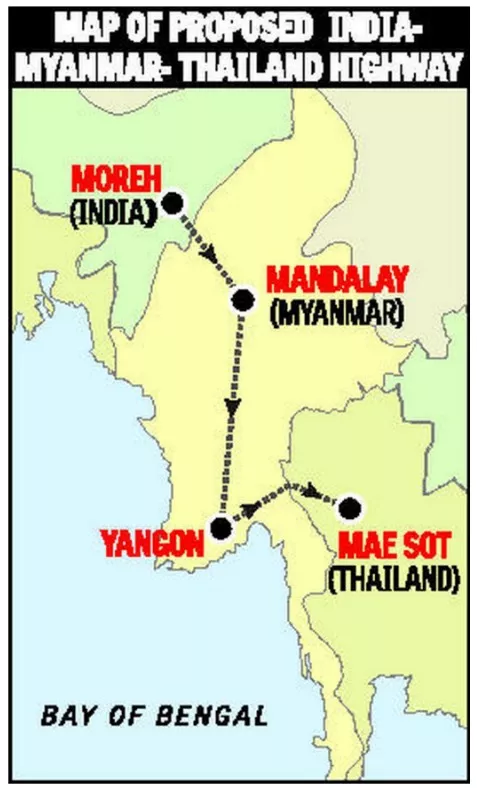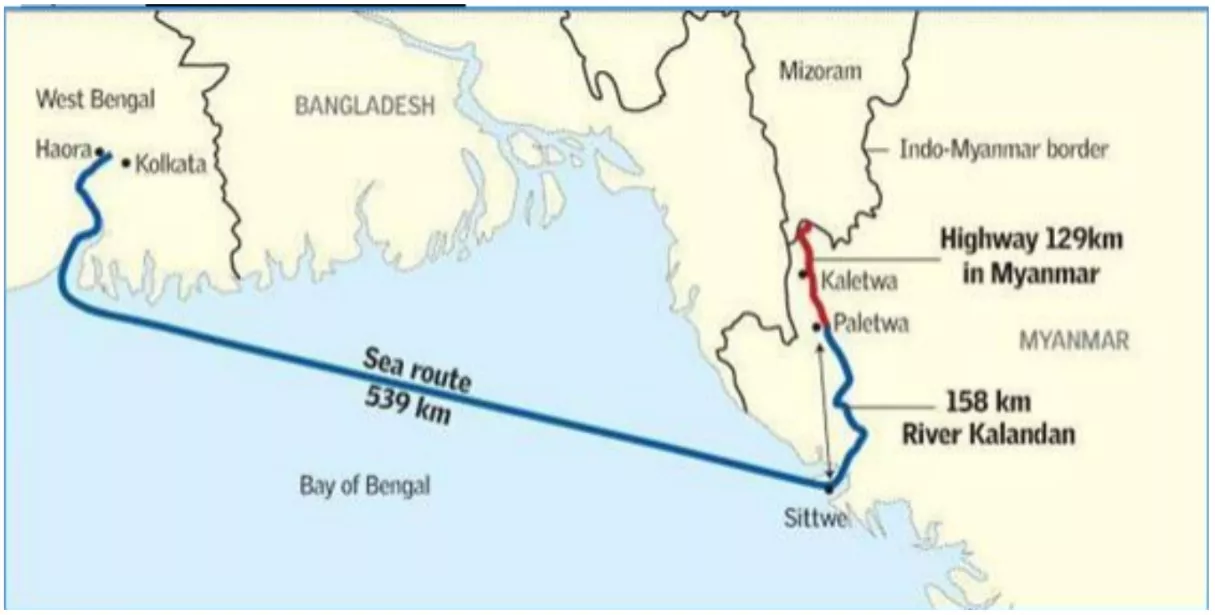Recently, The Prime Minister of India participated virtually in the 22nd ASEAN-India Summit held in Kuala Lumpur, Malaysia.
- The meeting reviewed the progress of the ASEAN-India Comprehensive Strategic Partnership and discussed future cooperation
- Theme Of This Year’s Asean Summit: “Inclusivity and Sustainability.”
East Timor (Timor-Leste) Has Officially Become The 11th Member Of ASEAN
- This is ASEAN’s first expansion since the 1990s. The last country to join ASEAN was Cambodia in 1999.
- East Timor applied for ASEAN membership in 2011, was granted observer status in 2022, and achieved full membership in 2025 after a 14-year wait.
- About East Timor (Timor-Leste)
-
- Sovereign island nation in Southeast Asia, and one of the world’s youngest republics (Got independence in 2002).
- It had previously been a Portuguese colony and was later occupied by Indonesia from 1975 to 1999.
- It lies in the eastern half of Timor Island in the Malay Archipelago, bordered by Indonesia to the west, and the Timor Sea (north of Australia) to the south.

|
Key Highlights Of the 22nd India-ASEAN Summit
- Strengthening ASEAN-India Comprehensive Strategic Partnership: The leaders adopted the ASEAN-India Plan of Action (2026–2030) to implement the Comprehensive Strategic Partnership.
- PM Modi reiterated that the review of the ASEAN-India Trade in Goods Agreement (AITIGA) would unlock the partnership’s full economic potential.
Key Highlights of the 21st East Asia Summit
- 10-Point Plan: Prime Minister Narendra Modi unveiled a 10-point plan to bolster the ASEAN-India Comprehensive Partnership at the 21st ASEAN-India Summit.
- Maritime Cooperation: ASEAN and India agreed to enhance collaboration between the ASEAN Outlook on the Indo-Pacific (AOIP) and the Indo-Pacific Oceans Initiative (IP
- OI).
- ASEAN-India Plan of Action: The leaders agreed to create a new ASEAN-India Plan of Action (2026-2030) to realise the full potential of the ASEAN-India partnership
- Counter Terrorism Cooperation: India’s co-chairmanship of the ASEAN Defence Ministers’ Meeting (ADMM)-Plus Experts’ Working Group on Counter-Terrorism for 2024-2027 was highlighted in the Summit.
- Reviewing AITIGA: Both sides emphasised the need to expedite the review of the ASEAN-India Trade in Goods Agreement (AITIGA).
|
- Maritime and Defence Cooperation:
- Declaration of 2026 as the ASEAN-India Year of Maritime Cooperation to forge partnerships in blue economy
- Proposal to hold the Second ASEAN-India Defence Ministers’ Meeting and the Second ASEAN-India Maritime Exercise, reinforcing maritime domain awareness and security.
- Announcement of the East Asia Summit Maritime Heritage Festival at Lothal, Gujarat, and a Conference on Maritime Security Cooperation.
About East Asia Summit (EAS)
- Established: In 2005 as an ASEAN-led initiative.
- Aim: It emphasises openness, inclusiveness, respect for international law, and ASEAN centrality, with ASEAN acting as the driving force.
- Membership: It has 18 members: 10 ASEAN countries (Brunei, Cambodia, Indonesia, Laos, Malaysia, Myanmar, Philippines, Singapore, Thailand, Vietnam) and eight Non ASEAN Member States (Australia, China, India, Japan, New Zealand, South Korea, Russia, and the United States).
|
What are Quick Impact Projects (QIPs)?
- QIPs are initiatives designed to deliver direct and tangible benefits to local communities within a short time frame, especially in areas with critical infrastructure and social development needs.
- They are focused on addressing urgent and immediate issues that can have a significant positive impact on the community.
|
- Inclusive and Sustainable Development: Adoption of the ASEAN-India Joint Leaders’ Statement on Sustainable Tourism as part of the ASEAN-India Year of Tourism (2025).
- India extended Quick Impact Projects (QIPs) to Timor-Leste and announced the training of 400 professionals in renewable energy to support the ASEAN Power Grid initiative.
- Education, Research, and Human Development: Proposal for establishing a Centre for Southeast Asian Studies at Nalanda University to enhance regional expertise.
- Commitment to enhance cooperation in education, science & technology, fintech, cultural heritage, semiconductors, and critical minerals.
- Global Peace and Security: PM Modi called for unity against terrorism, describing it as a major threat to global peace.
- India reiterated its role as a First Responder during crises in the region, focusing on Disaster Preparedness and HADR (Humanitarian Assistance and Disaster Relief).
ASEAN–India Plan of Action (2026–2030)
1. Political and Security Cooperation
- Support for ASEAN Centrality: Reinforces ASEAN’s leadership in the regional architecture and adherence to international law.
- Defence & Security: Promote cooperation via ASEAN Defence Ministers’ Meeting Plus (ADMM-Plus) , ASEAN Regional Forum, East Asia Summit, focusing on maritime security, counter-terrorism, peacekeeping, and cybersecurity.
- Cybersecurity & Counter-Terrorism: Enhanced cooperation through the ASEAN-India Cyber Policy Dialogue and support for ASEAN’s anti-terror frameworks.
2. Economic Cooperation
- Trade & Investment: Expedited review of AITIGA to make it simpler, more trade-facilitative, and inclusive.
- Promote MSMEs, start-ups, and women-led enterprises.
- Enhance ASEAN-India Business Council engagement.
- Energy: Support ASEAN Power Grid, Green Fund projects, clean energy technologies (hydrogen, CCUS), and cooperation in civil nuclear energy.
- Transport Connectivity: Accelerate India–Myanmar–Thailand Trilateral Highway, explore extension to Cambodia, Laos, and Vietnam, and boost maritime logistics.
- Food, Agriculture & Forestry: Focus on climate-smart agriculture, digital farming, and sustainable food systems using the ASEAN-India Green Fund.
3. Digital, Technology & Innovation Cooperation
- ICT & Digital Economy: Capacity building in AI, IoT, 5G, e-commerce, cybersecurity, and space collaboration.
- Digital Transformation: Use India Stack for regional Digital Public Infrastructure (DPI) initiatives.
4. Cross-Pillar Cooperation
- ASEAN Outlook on the Indo-Pacific (AOIP): Deepen cooperation in maritime, connectivity, SDGs, and economic areas under AOIP.
- Connectivity: Link India’s Act East Policy and SAGAR vision with ASEAN’s Connectivity Strategic Plan (ACSP).
- Smart Cities: Collaboration with ASEAN Smart Cities Network (ASCN) for resilient and innovative cities.
|
Evolution of ASEAN-India Dialogue Relations
- Early 1990s: India introduced the Look East policy to strengthen ties with Southeast Asia.
- Initial Growth (1992-2002)
- ASEAN-India Relations began as a sectoral dialogue partnership in 1992, elevated to a full dialogue partnership by 1995.
- First ASEAN-India Summit held in 2002, marking rapid progress in their cooperation.
- Strategic Partnership (2012)
- In 2012, ties were elevated to a Strategic Partnership as ASEAN and India celebrated 20 years of dialogue.
- The ASEAN-India Eminent Persons Group was formed to review and strengthen relations.
- Act East Policy: The Act East policy emphasises a more proactive approach, encompassing not only ASEAN countries but also expanding focus to include other Indo-Pacific nations such as Australia, New Zealand, Japan, and South Korea.
- Comprehensive Strategic Partnership (2022)
- In 2022, both sides established the ASEAN-India Comprehensive Strategic Partnership and celebrated 30 years of mutually beneficial partnership.
About ASEAN – Association of Southeast Asian Nations
- Establishment: 8 August 1967 in Bangkok, Thailand with the signing of the ASEAN Declaration (Bangkok Declaration).
- Founding members: Indonesia, Malaysia, Philippines, Singapore, Thailand.
- Motto: “One Vision, One Identity, One Community”.
- Members: 11 Members:
- Indonesia, Malaysia, Philippines, Singapore, Thailand, Brunei Darussalam (1984), Vietnam (1995), Lao PDR and Myanmar (1997), Cambodia (1999) and East Timor (2025)
- Chairmanship: Chairmanship rotates annually, based on the alphabetical order of the English names of Member States.
|
Significance of India-ASEAN Partnership

- Economic Significance:
- Trade:
- In 2024, ASEAN accounted for 9.8 percent of India’s exports and 10 percent of its imports, keeping its overall trade share around 9.9 percent
- Machinery and electrical goods made up 23 percent of India’s imports from ASEAN in 2024
- On the export side, India’s trade basket concentrated in fuels, chemicals, and metals, which together account for over 45 percent of total shipments.
- India-ASEAN trade had doubled to over USD 130 billion in the past decade.
- The ASEAN-India Free Trade Area (FTA) has increased bilateral trade, and bilateral trade between the two stands around 123 Billion USD (2024-25).
- ASEAN-India Trade in Goods Agreement (AITGA) is a Free Trade Agreement (FTA) signed in 2009 to boost trade ties.
- Singapore is India’s largest trade partner in ASEAN and is a significant source of foreign direct investment (FDI).
 Strategic Significance:
Strategic Significance:-
- Countering China’s Influence: ASEAN is a key strategic partner for India, particularly amidst rising geopolitical tensions with China.
- Alignment of India’s ‘Act East Policy’ with ASEAN’s Indo-Pacific Outlook: India’s ‘Act East Policy’ and ASEAN’s ‘Outlook on the Indo-Pacific’ share similar visions for ensuring regional stability and security.
- India’s Role in Regional Security: India engages with ASEAN through forums like the East Asia Summit and ASEAN Regional Forum to position itself as a net security provider.
- Regional Connectivity: Key Infrastructure Projects such as India-Myanmar-Thailand Trilateral Highway and Kaladan Multi-Modal Transit Transport Project are vital for enhancing regional connectivity with Southeast Asia.
- They also serve as alternatives to China’s Belt and Road Initiative in the region.

| ADMM-Plus: A platform for dialogue and practical cooperation between ASEAN Defence Ministers and eight dialogue partners — India, China, Japan, South Korea, Australia, New Zealand, Russia, and the United States. |
- Defence Collaboration: India and ASEAN have strengthened defence ties through joint military exercises like the ASEAN-India Maritime Exercise and participation in the ASEAN Defense Ministers’ Meeting Plus (ADMM+).
- India views ASEAN as central to its Indo-Pacific strategy for regional security and growth, represented by the SAGAR (Security and Growth for All in the Region) initiative.
- Others:
- Funding and financial assistance: India has supported ASEAN countries through various funds like the ASEAN-India Cooperation Fund, the ASEAN-India S&T Development Fund, and the ASEAN-India Green Fund, aimed at enhancing cooperation in different sectors.
- Education and Research: India has established the ASEAN-India Centre at the Research and Information System for Developing Countries (RIS) to facilitate studies on ASEAN-India relations.
- First Responder in HADR: India has been among the first responders in providing Humanitarian Assistance and Disaster Relief (HADR) to the region.
- Example: India launched Operation Sadbhav to deliver disaster relief to Laos, Myanmar, and Vietnam in response to severe flooding caused by Typhoon Yagi, in line with its long-standing ‘Act East’ Policy.
Challenges in India-ASEAN Relations
- Lack of Market Access: Some Indian products do not have market access in ASEAN countries due to factors such as high tariffs and non-tariff barriers.
- The absence of mutual recognition agreements in professional services restricts the mobility of skilled professionals.
- Despite the 2009 AITIGA, India faces limited access to ASEAN markets, as several members offered lower tariff liberalisation e.g., India opened 71% of tariff lines, while Indonesia opened only 41%.
- This asymmetry has restricted India’s exports and deepened the perception of an unbalanced FTA
- Impact of External Tariff Pressures: The imposition of 25% U.S. tariffs on Indian goods (additional 25% tariff) has exposed India’s vulnerability and renewed urgency to diversify trade through ASEAN and other FTAs.
- Meanwhile, ASEAN exporters enjoy lower U.S. tariff rates (range from 10 percent for Singapore to 40 percent for Myanmar and Laos), giving them a competitive edge over Indian goods globally.
- ASEAN Strict Rules of Origin: The India-ASEAN Free Trade Agreement (FTA) has strict rules of origin, making it challenging for Indian exporters to qualify for tariff reductions.
- Misuse of ASEAN FTA: There are reports of goods being rerouted from China through ASEAN countries with minimal value addition, misusing the FTA benefits.
- India has raised concerns about the misuse of AITIGA’s Rules of Origin (ROO), as Chinese goods are re-routed via ASEAN with minimal value addition, undermining India’s domestic industry.
- This has created unfair competition and reduced the effectiveness of tariff benefits for genuine ASEAN-origin goods.
Regional Comprehensive Economic Partnership (RCEP) is an economic agreement between ASEAN members and Free Trade Agreement (FTA) partners.
- Members: 15 member countries, such as China, Japan, New Zealand, South Korea, Australia, and ASEAN nations( Brunei, Cambodia, Indonesia, Laos, Malaysia, Myanmar, the Philippines, Singapore, Thailand, and Vietnam).
|
- Trade Imbalance: India’s trade deficit with ASEAN has more than doubled since the Free Trade Agreement (FTA) was implemented in 2010, particularly in sectors like electronics and machinery due to issues related to implementation, customs procedures, and non-tariff barriers etc.
- Trade deficit in 2016-17 was $ 9.66 billion, which increased to $45.2 billion in 2023-24
- India’s Withdrawal from RCEP: India’s decision to withdraw from the Regional Comprehensive Economic Partnership (RCEP) has led to significant economic disappointment among ASEAN members.
- Infrastructure Connectivity Challenges: Physical infrastructure links remain underdeveloped. Example: The India-Myanmar-Thailand Trilateral Highway, has faced significant delays and remains incomplete.
- China Factor: India’s attempts to counterbalance China, such as through the Quad Alliance, receive mixed reactions from ASEAN countries.
- Cooperation has also been affected by China’s claims over the South China Sea (many of which compete with claims of ASEAN members like the Philippines and Brunei) and the issue of military conflict in its member country, Myanmar.
Measures to Improve India-ASEAN Relations
- Recalibrating the ASEAN-India Free Trade Agreement (AIFTA): There is a need to review AIFTA to address trade imbalances and negotiate balanced tariff reductions in key sectors like pharmaceuticals, textiles,and greater market access for services.
- Enhancing Infrastructure Connectivity: Accelerate key projects such as the India-Myanmar-Thailand Trilateral Highway, extending it to Cambodia, Laos, and Vietnam.
- Develop a “Connectivity Master Plan” aligned with ASEAN’s Master Plan on Connectivity 2025, including digital initiatives like the India-ASEAN submarine cable project.
- Boosting Manufacturing Competitiveness: Extend the Production Linked Incentive (PLI) scheme to boost competitiveness in industries critical for ASEAN trade.
- Expanding QUAD to QUAD+: The concept of the Quadrilateral Security Dialogue (QUAD) should be expanded to include ASEAN countries, creating a QUAD+ arrangement.
- Expanding Semiconductor Diplomacy in ASEAN: India should expand its semiconductor diplomacy with Malaysia and Singapore to include other ASEAN nations, enhancing collaborations in semiconductor manufacturing.
- Strengthening Cultural Connections: via Tourism, Collaborative productions in cinema, music, and television, Offering language courses for ASEAN languages in India and vice versa , etc can deepen relations.
Conclusion
The 22nd ASEAN–India Summit marked a new phase of cooperation driven by sustainability, maritime security, and economic balance. With the implementation of the ASEAN–India Plan of Action (2026–2030), both sides aim to build a stable, inclusive, and prosperous Indo-Pacific region.
![]() 27 Oct 2025
27 Oct 2025



 Strategic Significance:
Strategic Significance:
